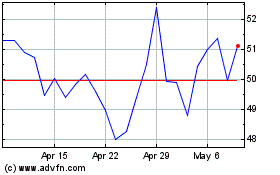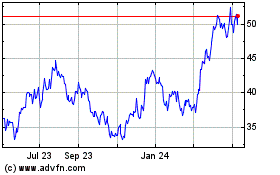By Theo Francis and Richard Rubin
The U.S. tax overhaul has lowered tax rates for many companies,
and many others that were already toward the bottom of the scale
have been able to stay there so far, a Wall Street Journal analysis
shows.
The lower rates follow tax-law changes Congress passed at the
end of 2017. Since then, the Journal analysis shows, the median
effective global tax rate for S&P 500 companies declined to
19.8% in the first quarter of 2019 from 25.5% two years
earlier.
That marked the third straight quarter below 20% and is
consistent with the goals and structure of the tax overhaul, which
lowered the federal corporate rate to 21% from 35%. The law's
authors wanted to help U.S. multinationals compete in foreign
markets and aid domestic companies with high tax burdens, while
reducing the value of tax breaks and making it harder to achieve
single-digit tax rates.
Much of the decline is coming because fewer firms are paying
rates at the highest end, according to the Journal analysis. Just
28 companies, including mining giant Freeport-McMoRan Inc. and
Chevron Corp., reported a global tax rate above 32% in the first
quarter, down from 143 before the overhaul.
The Tax Cuts and Jobs Act of 2017 limited deductions and
introduced new minimum taxes on overseas income, though some of the
bite of those changes was delayed to beyond 2020. Thus, 119 S&P
companies including Adobe Inc. and General Motors Co. paid global
tax rates below 12% in the first quarter. That is up from 93
companies before the overhaul.
Companies typically don't make public what they pay the Internal
Revenue Service each tax year. But public companies do disclose
their effective tax rates: the measure of taxes incurred under
generally accepted accounting principles as a share of pretax
income.
Those rates reflect global results and include foreign and state
taxes, not just what companies owe the U.S. Treasury Department.
Quarterly results can bounce around, swayed by one-time events. For
many big companies, however, U.S. federal taxes are the most
important component.
A quarter of S&P 500 companies reported effective global tax
rates below 21% in each of the past four quarters, the Journal
analysis found. Companies can wind up paying less than the
statutory rate, even on U.S. income, thanks to a variety of breaks
that lower their tax bills, including a deduction for exports and
credits for corporate research.
The Journal's analysis, using figures from financial-data firm
Calcbench Inc., omits tax rates reported for the last three months
of 2017 and the first three months of 2018 -- quarters in which
many companies booked big, one-time changes driven by the tax law.
Results were similar when real-estate companies, which tend to
report very low tax rates, were omitted. (See methodology note for
more detail.)
A separate analysis, from S&P Dow Jones Indices, found
similar shifts in income-tax rates for S&P 500 companies since
the tax law's enactment.
Outside the U.S., companies pay local tax rates that can be much
lower than what the IRS charges. In some cases, those low foreign
rates will trigger a new residual U.S. tax. The Global Intangible
Low-Taxed Income, or GILTI, provision is intended to ensure
companies pay at least 10.5% on most foreign income. Those factors
create variation among companies, as do periodic settlements with
tax authorities, the mix of countries where profits are booked and
other anomalies.
The decline in the median effective tax rate points to what
could be an even more significant shift: The range of tax rates
reported by most big companies has contracted following the new
law.
In a broad sense, compressing corporate tax rates was one of the
goals of the overhaul. Those paying the most, including heavily
domestic companies such as retailers and utilities, could expect to
pay less, while those with the lowest rates, often tech and
pharmaceutical companies that some say engaged in offshore
tax-avoidance maneuvers, could expect to pay more because of
GILTI.
Take, for example, Zoetis Inc., a maker of veterinary drugs. Its
tax rate fell to 18% in the first quarter from 28% two years
earlier. While much of that decline stemmed from the reduction in
the corporate tax rate, changes outside the U.S. and one-time
accounting adjustments also had an effect.
Zoetis said its world-wide tax rate has declined by 7 to 8
percentage points as a result of the tax overhaul. The company said
the global-minimum GILTI tax is expected to increase its rate in
2019 by about 1 percentage point. That tax is just starting to
affect the company in 2019 because of when its foreign subsidiaries
begin their fiscal year.
Lower rates mean less tax revenue for the government. So far
this fiscal year, the federal government has collected $164 billion
in corporate taxes, up 2% from the prior year as the economy
continues growing, but 26% below where they were in the comparable
period before the tax law took effect.
Not all companies posted lower tax rates. About a quarter of the
S&P 500 reported rates similar to those they disclosed before
the overhaul, and about 17% said that their rates rose by 5
percentage points or more in recent quarters.
One company with consistent increases was Hanesbrands Inc. The
company reported a tax rate averaging 14% over the four quarters in
the Journal analysis following the tax law's enactment, up from an
average of just under 6% before the tax-law change.
The new global minimum tax, together with another provision,
added about 2.3 percentage points to Hanesbrands's tax rate in
2018. Other breaks and adjustments mostly offset each other for the
year.
The company confirmed its global tax rate rose with the tax
legislation. About 60,000 of its 68,000 employees work in
facilities outside the U.S. "By virtue of owning and operating our
own global supply chain, our tax rate is lower than the U.S.
statutory rate," a Hanesbrands spokesman said. "That is one of the
benefits of our business model to own and operate the majority of
our global supply chain."
Policy makers added several provisions to the tax code,
including the GILTI global minimum tax, intended to make it harder
for companies to book profits at ultralow tax rates in foreign
jurisdictions without paying U.S. taxes on top of that.
Some companies with very low tax rates have managed to maintain
them for now. Adobe said its fiscal year ended in November, so the
GILTI tax and other provisions of the new law didn't take effect
until this fiscal year.
Semiconductor maker Xilinx Inc. reported quarterly tax rates of
about 6% to 13% before the new law, compared with 6% to 11% after
the overhaul.
In both periods, the chip designer -- with products used in 5G
networking equipment -- benefited from the bulk of its pretax
income being attributed to foreign markets: 82% in its most recent
year.
Xilinx, which has a regional headquarters and manufacturing
facility in Singapore, has received "Pioneer Status" from the
government there and benefits from a preferential zero tax rate
through its 2021 fiscal year.
The company said its obligations under the GILTI tax on foreign
earnings offset a portion of the benefit from its low foreign
rates. Even so, the company's global tax rate was below 11% in each
of the past four quarters and below 7% in two of them.
A Xilinx spokesman declined to comment beyond disclosures in its
securities filings.
WSJ Methodology
The Journal analyzed quarterly disclosures for companies in the
S&P 500 index. It calculated tax rates by dividing the
provision for income taxes by pretax income, as provided by
financial-data firm Calcbench.
Quarterly periods were aligned so the quarter including the date
of the tax law's enactment, Dec. 22, 2017, was treated as the
fourth quarter of 2018 for all companies, with other quarters
renamed accordingly. Results for the fourth quarter of 2017 and the
first quarter of 2018 were generally omitted from the analysis
because tax rates for many companies were dramatically skewed by
one-time accounting effects from adopting provisions of the
law.
Individual companies' tax rates can swing dramatically from
quarter to quarter for a variety of reasons, including settlements
with tax authorities and the effects of mergers and acquisitions.
The analysis used median tax rates to minimize distortion caused by
outliers. In addition, because of the volatility, the analysis of
tax-rate convergence omitted the 10% of companies with the highest
tax rates and the 10% with the lowest rates in each period.
Write to Theo Francis at theo.francis@wsj.com and Richard Rubin
at richard.rubin@wsj.com
(END) Dow Jones Newswires
July 21, 2019 18:31 ET (22:31 GMT)
Copyright (c) 2019 Dow Jones & Company, Inc.
Freeport McMoRan (NYSE:FCX)
Historical Stock Chart
From Mar 2024 to Apr 2024

Freeport McMoRan (NYSE:FCX)
Historical Stock Chart
From Apr 2023 to Apr 2024
